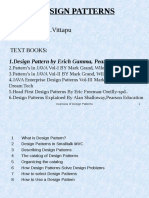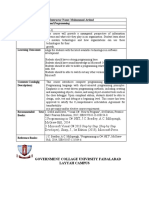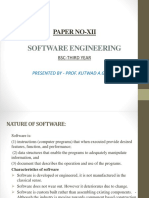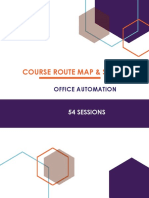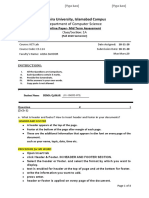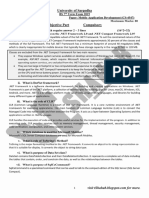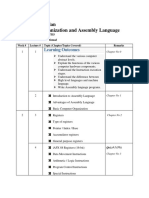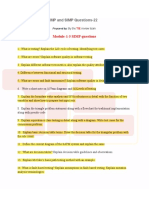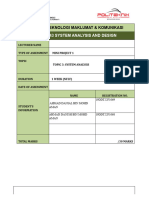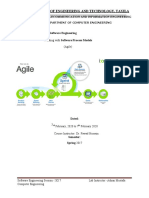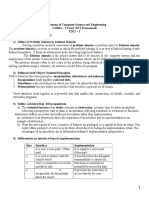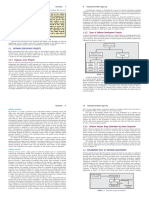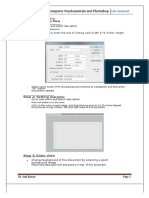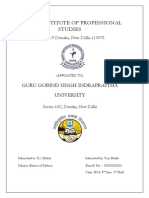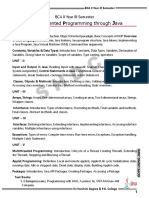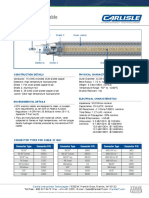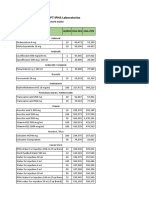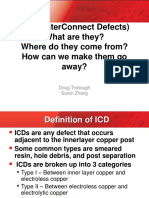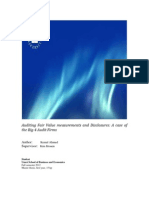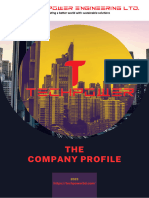Course Outline - Professional Practices - Fall 2023
Uploaded by
shahfaisal gfgCourse Outline - Professional Practices - Fall 2023
Uploaded by
shahfaisal gfgUniversity of Management and Technology
HU-4092 Professional Practices
Resource Person: Kamran Hameed
Email: Kamran.hameed@umt.edu.pk
Contact Hours: Monday 11:15 am to 1:15 pm
Wednesday 10:00 am to 12:00 pm
Office Address: C3-20
Programme: BSCS, BSCS, BSSE, BSAI
Section: Y1
Semester: Fall 2023
Course Pre-requisites: Introduction to Computing
Credit Hours: 3
Course Type: In-Person
Venue/Day/Time: Tuesday & Wednesday
Course URL (if any):
Course Description:
This course is specifically designed to provide introduction to professional practices and
responsibilities of professional. We are focusing on diverse practices by information technology
professionals, organizational structures, functions, processes, ethical decision making, and codes of
ethics. It will help students gain in-depth knowledge mainly on organizational professional practices in
place and an understanding of ethics for IT professionals, internet issues and computer crimes,
privacy., freedom of expression, intellectual property issues, software development and decision
making, social media use and ethical implication and plagiarism. This course will develop students’
understanding for the professional and ethical issues related to the discipline of computing and
information technology. This will prepare students to learn, analyze, evaluate, assess and tackle
professional and ethical issues at workplace.
Course Teaching Methodology:
A mixed method pedagogy will be adopted comprising of lectures, discussions, class activities,
research articles, case studies, presentations, industry reports and other formative and summative
assessments. The course teaching methodology is designed in a manner that each session’s learning
outcomes can be linked to the achievement of the overall course objectives and eventual program
objectives.
UMT Course Outlines Page 1 of 14
University of Management and Technology
Programme Learning Outcomes (PLOs):
After completing this degree programme, students shall be able to:
Mapping the
PLOs with
POs
PLO-1 Have a broad understanding of the most recent theoretical and practical
aspects of the subject.
PLO-2 Be able to apply their knowledge to provide solution to practical
problems
PLO-3 Have appropriate communication skills to play a lead role in their
practical career
PLO-4 Have hands on experience of the most resent technologies
Course Objectives (COs) Bloom’s Taxonomy
Mapping
CO-1 To familiarize students with professional practice in computer Level 2 - Comprehension
science.
CO-2 To enable them to: identify ethical conflicts, identify their Level 4 - Analysis
responsibilities and options, and think through the implications
of possible solutions to ethical issues.
CO-3 To enable students make an appropriate decision in their Level 3 - Application
professional lives with difficult situations involving (ethical Level 4 - Analysis
issues, violation of professional code of practices, legal issues,
privacy boundaries, and cyber and workplace crimes) and
make a positive impact in the field of IT.
CO-4 To enable students to learn organizational structures, functions Level 2 - Comprehension
and processes.
CO-5 To enable students identify risk in use of computing Level 4 - Analysis
technologies and provide precautions.
CO-6 To enable student to discuss various legal, social and ethical Level 4 – Analysis
issues in the IT.
UMT Course Outlines Page 2 of 14
University of Management and Technology
Course Learning Outcomes (CLOs):
After completing this course, students shall be able to:
Mapping Bloom’s
the CLOs Taxonomy
with PLOs Mapping
CLO-1 Develop awareness of themselves as members of a Level 2 -
profession, with shared community principles Comprehension
CLO-2 Develop awareness of the ethical implications of their Level 2 -
professional choices, and of the communities Comprehension
CLO-3 Understand various organizational dimensions and issues Level 2 -
related to them Comprehension
CLO-4 Identify and evaluate ethical / social issues and tradeoffs in Level 4 -
technical decisions Analysis
CLO-5 Display reasoned decision making processes leading to Level 3 -
professional outcomes Application
CLO-6 Express complex ideas accurately in written and spoken Level 4 -
formats suited to the workplace contexts Analysis
CLO-7 Understand the successful role of professionals in managing Level 2 -
organizations Comprehension
Assurance of Learning and Assessment Items:
Specify Assessment Items that will assure student learning through application and achieve objectives of
specific PLOs / COs / CLOs
Assessment Item Application/ Objectives
PLO / CO / CLO
Quizzes [CO: 2, 3, 4, 6] & [CLO: 1, 2, 4, 5]
Assignments [CO: 1, 3, 4, 6] & [CLO: 2, 3, 7] (Appendix – A Rubric)
Cases & Discussion Forum [CO: 2, 5, 6] & [CLO: 1, 6, 7]
Activities [CO: 1, 2, 3, 4, 5, 6] & [CLO: 1, 2, 3, 4, 5, 7]
Class Participation [CO: 1, 2, 3, 4, 5, 6] & [CLO: 1, 2, 3, 4, 5, 7] (Appendix – B
Class Participation)
Mid-term exam [CO: 1, 2, 3, 4, 5, 6] & [CLO: 1, 2, 3, 4, 5, 7]
Project, Presentation & Viva [CO: 1, 2, 3, 4, 5, 6] & [CLO: 1, 2, 3, 4, 5, 6, 7] (Appendix – C -D
Project Report and Presentation)
Assessment Structure and Grading Policy*:
Assessment Item Weight (%) Execution Plan
Quiz 10 5 (N-1) [All Announced]. Objective/Subjective Type (Individual)
Assignment 10 2 (Can be Individual or Group Based).
Rubrics will be shared for each Assignment along with Assignment
Instructions
Class Activity & 5 Case snippets shared in each week
Discussion 2 Case Analysis: Written analysis & class discussion
Class Participation 5 8-10 Classes [Please see Notes and Rubrics for CP requirements]
Mid-term exam 25 One-time assessment
Final Project & 15 One-time assessment (Group Based)
Presentation
UMT Course Outlines Page 3 of 14
University of Management and Technology
Final exam 30 One-time assessment (Individual)
Total 100
Notes – Norms and Important Class Policies:
(such as submission guidelines, academic honesty, make-up policy, code of conduct)
Students are required to read and understand all items outlined in the participant handbook
Be On Time
CLASS PARTICIPATION: Just being present in class does not count for CP, nor does a simple
Yes/No answer constitutes it. CP marks are awarded when the participant provides thoughtful,
cohesive and intellectually stimulating arguments, reasoning, opinions, discussions answers etc. This
can be achieved when the participant comes prepared by studying all Reading Materials [RM} in
advance.
TURN OFF YOUR MOBILE PHONE! It is unprofessional to be texting or otherwise
A minimum of 80% attendance is required for a participant to be eligible to sit in the final examination.
This means that 06 sessions (1 Hours 15 Minutes) each are allowed. If the participant is absent in the
7th Session, it will result in SA Grade.
Students may withdraw from a course till the end of the 12th week of the semester
Participants should regularly visit the course website on MOODLE Course Management system, and
fully benefit from its capabilities.
Sexual or any other harassment is prohibited and is constituted as punishable offence. Sexual or any
other harassment of any participant will not be tolerated
All assignments will be submitted electronically on their respective cutoff date and time. Make sure
you view assignment details on Moodle
All assignments/other submissions should include 1 formal title page (click here to access the APA
style Title page format). Sample of both have been uploaded on Moodle
All assignments will be submitted into “turn it in’ © to check for plagiarism and similarity index.
Plagiarism of xx and above and similarity index of YY and above will lead to cancellation of
submission and case will be forwarded for further verdict.
*Rubrics for all assessments (including mid and final exams) will be provided separately to the students.
Weekly Sessions Plan:
Week Topics / Contents Activity Application/
Objectives
PLO / CO / CLO
1 Course Introduction One to one discussion
Students’ introduction
Recourse person introduction Activity 1: Assessing Personal
Discussion on overview of ethics, Values CO2, CO3, CLO1,
importance of integrity and CLO2
difference between ethics,
morality and laws
Discussion on ethics in business
world and in information
technology CO1, CO2, CLO1,
Contemporary trends in CLO4
professional practice:
Summary course outline &
session topics CO1, CLO1, CLO4,
Setting ground rules
UMT Course Outlines Page 4 of 14
University of Management and Technology
2 Who are Professionals and Lecture
Professional Ethics Case Analysis
Describing professionals Group Discussion
Preparing your "Personal CO3, CO4, CLO2,
Professional Pitch". Video: Ethics, Yes, Even Nobody is CLO3, CLO7
Profession, Fundamental Watching by Dawne Ware
characteristics of a profession, https://www.ted.com/talks/
Structure of computing dawne_ware_ethics_yes_even_whe CO1, CLO2
profession, n_nobody_is_watching
Ethics, Professional Ethics, CO1, CO4, CO5,
Ethical issues of Computer Video: Here's Why Only 2% CLO2, CLO7
Science, Succeed and 98% Don't! | Warren CO1, CO2, CO6,
Buffett's Secrets for Success. CLO2, CLO5
Professional codes of conduct,
https://www.youtube.com/watch? CO5, CLO4
Ten Commandments of
v=iEgu6p_frmE CO1, CO3, CLO2,
computer ethics,
CLO5
Applying codes of conduct. Activity 2: Assessing Ethical CO1, CO3, CLO2,
Ethical and rational decision Responsibilities of Computer CLO5
making by professionals Professionals CO3, CO5, CLO4,
CLO5
Discussion on Final Project
3 The Structure of Organizations Lecture
Companies, Case Analysis CO1, CO2, CO4,
Constitution of company, Group Discussion CLO1, CLO2, CLO3,
Disclosure requirements, CLO7
Organizing an organization, Video: It's The Big HR Ethical Issue CO1, CO7, CLO1,
functional units of an https://www.youtube.com/watch? CLO4
organization, v=1OgxTaWZwH0 CO4, CLO3, CLO7,
Centralization vs decentralization
Management Video: Ethical Issues in Employment CO2, CO4, CLO4,
https://www.youtube.com/watch? CLO7
What are human resources?
v=AylEkNHOhNs CO3, CO4, CLO2,
Four Key Functions of HRM
CLO4, CLO7
Redundancy, dismissal and Activity 3: Understanding the
grievance procedures Strategic Decision Making Process CO2, CLO3, CLO7
Contracts of employment of Apple
Inc.https://www.youtube.com/watch?
v=qp0HIF3SfI4
Final Project Step 1: Selection of
Company (500 -1000 words) (week 4
submission)
4 Managing People Lecture
Management functions in Case Analysis CO4, CLO7
managing professionals Group Discussion
Centralization vs decentralization
What are human resources? Quiz 1 (session 1 & 2)
Four Key Functions of HRM CO2, CLO2, CLO5
Redundancy, dismissal and Video: Integrating Ethics into
grievance procedures General Management by Lynn Sharp
Understanding behavior, Paine
www.youtube.com/watch? CO6, CLO4
Selecting the right person for a
v=XQh4SpNkW40
job,
UMT Course Outlines Page 5 of 14
University of Management and Technology
Stress management,
Ethical and professional Activity 4: Case on Critical
concerns Management Skills
Final Project Step 2: Topic
Selection (1000-1500 words) (week
6 submission as Assignment 2)
5 Legal and Ethical Aspects in IT Lecture
Organizations Case Analysis
Ethical and legal standards in an Group Discussion CO1, CO2, CLO1,
organization Assignment 1 allocated CLO2
Employee rights in workplace Quiz 2 (session 3 & 4)
Difference between employee CO1, CO3, CLO2,
and employee rights CLO4
Characteristics of developed Video: Why Good Leaders Make
computing professions you Feel Safe
Software engineering code of https://www.ted.com/talks/simon_sin
ethics (IEEE-CS/ACM joint task ek_why_good_leaders_make_you_f
force on software engineering eel_safe
ethics and professional
practices) Activity 5: Case study - Analysis of
Analysis of ethic’s code and its Codes of Ethics of Systems Limited
fundamental principles
6 Computer and Internet Crimes
Reasons for prevalence of Lecture CO1, CO5, CO6,
computer crimes Case Analysis CLO1, CLO4
Types of exploits and Group Discussion CO3, CO5, CO6,
perpetrators Assignment 1 submission due CLO4
Federal laws for prosecuting
computer attacks Final Project Step 2: Topic CO2, CO3, CLO2,
Implementing trustworthy Selection (1000-1500 words) CLO5
computing CO1, CLO5
Response to cyberattack Video: Are We Facing an Ethics
Cyber Ethics: Concepts, Crisis CO3, CO6, CLO1
methodology and codes of cyber https://youtu.be/o2GxuXxsVbE CO3, CO5, CO6,
ethics. CLO4
Activity 6: Case Study on
Facebook Data Breach
7 Interpersonal and Organizational Lecture
Communication Case Analysis
Nonverbal communication, Group Discussion CO2, CO3, CLO2,
listening and questioning Quiz 3 (session 5 & 6) CLO6
Managing negotiation, conflict CO2, CLO2, CLO5,
and difference in at workplace Final Project Step 3: Interview CLO7
Effective team development, Guide/Protocol (1000-1500 words) CO4, CLO6, CLO7
decision making & meetings
Presentations Video: Ethics in Communication –
Why do We Need It?
https://www.youtube.com/watch?
v=SFLqxSFES0c
Activity 7: Assessing Cybercrime
Cases Reported in Pakistan
8 Mid Term Exam CO 1-6, CLO 1-7
UMT Course Outlines Page 6 of 14
University of Management and Technology
9 Intellectual Property Lecture
What is intellectual property? Case Analysis CO3,
Copyrights Group Discussion CO3, CO5, CLO4
Patents CO3, CO5, CLO4
Trade secrets Video: Cyber Crimes – Intellectual CO5, CO5, CLO4
Key issues of intellectual Property Rights CO3,
property https://www.youtube.com/watch?v=-
FyDsc5hqMI
Activity 8: Case Study – WiTECH
IPR Issue
10 Industry’s Corporate Social
Responsibility Lecture
Explaining CSR in IT Industry Case Analysis CO1, CO6, CLO1
Manufacturing component of Group Discussion CO3, CLO4
industry’s CSR requirements wrt Quiz 4 (session 7, 9 &10)
society and environment Assignment 2 Allocated
Local and international bindings CO3, CO5, CLO2,
and their benefits Activity 9: Exercise on Mapping CLO3, CLO4
Business Contributions to the
Sustainable Development Goals
(SDGs)
11 Social Media and Ethical practices Lecture
What is social media? Case Analysis CO3, CO5, CLO1,
Social networking platforms Group Discussion CLO2
Business applications of social CO3, CO4, CLO4,
media Assignment 2 submission due CLO5
Social networking ethical issues CO3, CO4, CLO4,
Ethical and rational decision Video: Ethical Issues in Social CLO5
making by professionals Media Usage CO2, CO6, CLO5,
https://www.youtube.com/watch? CLO7
v=Ydpb0yFMwG4
Activity 10: Case Study – Email
Exposed
Final Project Steps 4: Analysis and
Findings (1200-1500 words)
12 Writing and Researching
Professionally Lecture
Research and problem solving Group Discussion CO2, CO5, CO6,
(including mediated CLO2, CLO5, CLO6
communication) Activity 11: Developing Standard
Plagiarism Operating Procedures (SOPs) for CO2, CO5, CO6,
Consequences of plagiarism Good Research Practice CLO2, CLO6
Types of plagiarism CO2, CO5, CO6,
Guidelines for citing sources CLO2, CLO6
How to avoid plagiarism CO2, CO5, CO6,
CLO2, CLO6
Misuse of sources
13 Ambidextrous Professionals & Lecture
Ambidextrous Professional Case Analysis
Organizations Group Discussion
Exploiting and exploring CO5, CLO3, CLO7
A map of innovation O Reilly, C. A., & Tushman, M. L.
UMT Course Outlines Page 7 of 14
University of Management and Technology
Punctuated equilibrium and (2004). The ambidextrous
organizational evolution – organization. Harvard Business
technology cycles Review, 82(4), 74-83. CO3, CO6, CLO4
Organizing to innovate
The success syndrome:
Congruence as a managerial
trap
Ambidextrous professionals
14 Final Project Presentations Quiz 5 (session 11, 12 & 13) CO1-6, CLO1-7
Final Project Step 6: Final Project
Presentation (10-15 slides)
(submission with Final Project
Report and PPTs)
15 Final Project Presentations
16
17 Final Term Examination
Primary Text Book (s):
Johnson, C. E. (2021). Organizational ethics: A practical approach. SAGE Publications, Incorporated.
Quinn, M. J. (2020). Ethics for the information age. Boston: Pearson Education.
Reynolds, G. (2014). Ethics in information technology. Cengage learning.
Johnson, D. G., & Miller, K. (2002). Computer ethics. Pearson International.
Robbins, S. P., & Coulter, M. (2018). Management 14E. Pearson India.
Reference / Supplementary Reading (s):
Mujtaba, B. G., & Cavico, F. J. (2016). Developing a legal, ethical, and socially responsible mindset for
sustainable leadership. ILEAD Academy
Bott, F., Coleman, A., & Rowland, D. (2005). Professional issues in software engineering. CRC Press.
Bott, F. (2005). Professional issues in information technology. BCS. The Chartered Institute.
Jayakumar, V. Professional ethics and human values in engineering.
De George, R. T. (2008). The ethics of information technology and business. John Wiley & Sons.
Useful Online / Web Resources:
Determining Personal Values
https://www.mindtools.com/pages/article/newTED_85.htm
Ethics, Yes, Even Nobody is Watching by Dawne Ware
https://www.ted.com/talks/dawne_ware_ethics_yes_even_when_nobody_is_watching
Here's Why Only 2% Succeed and 98% Don't! | Warren Buffett's Secrets for Success.
https://www.youtube.com/watch?v=iEgu6p_frmE
It's The Big HR Ethical Issue
https://www.youtube.com/watch?v=1OgxTaWZwH0
Ethical Issues in Employment
https://www.youtube.com/watch?v=AylEkNHOhNs
Understanding the Strategic Decision Making Process of Apple Inc.
https://www.youtube.com/watch?v=qp0HIF3SfI4
UMT Course Outlines Page 8 of 14
University of Management and Technology
Integrating Ethics into General Management by Lynn Sharp Paine
www.youtube.com/watch?v=XQh4SpNkW40
Why Good Leaders Make you Feel Safe
https://www.ted.com/talks/simon_sinek_why_good_leaders_make_you_feel_safe
Ethics in Communication – Why do We Need It?
https://www.youtube.com/watch?v=SFLqxSFES0c
Cyber Crimes – Intellectual Property Rights
https://www.youtube.com/watch?v=-FyDsc5hqMI
Ethical Issues in Social Media Usage
https://www.youtube.com/watch?v=Ydpb0yFMwG4
UMT Course Outlines Page 9 of 14
University of Management and Technology
Rubric for writing assignment Student Name:
CATEGORY 4 3 2 1 Pts.
(8-10) (6-7) (5) (less than 5)
Amount of All questions answered All Questions are All questions are One or more
Information with sufficient detail and addressed and addressed, and most questions were not
(30%) examples. most questions questions answered - addressed.
answered with at detail is lacking
least minimal
detail - and at
least one
example.
Quality of Argument clearly relates Argument clearly Argument clearly Argument has little
understanding to the main topic. Points relates to the relates to the main or nothing to do with
(25%) are clearly made. main topic. topic. Points are the main topic. There
Analysis is sophisticated Points are made, insufficiently is no critical analysis.
but analysis is developed. Analysis is
weak. minimal
Level of Examples All examples of CSR All examples of All examples of CSR Examples of CSR
(25%) Practices were strongly CSR Practices Practices were practices were
related. were collected collected rightly but neither collected nor
rightly but not related properly. related
insufficiently
related.
Mechanics No grammatical, spelling Almost no A few grammatical Many grammatical,
(10%) or punctuation errors. grammatical, spelling, or spelling, or
spelling or punctuation errors. punctuation errors.
punctuation
errors
Organization Information is very Information is Information is The information
(10%) organized with well- organized with organized, but appears to be
constructed paragraphs well-constructed paragraphs are not disorganized.
and subheadings. paragraphs. well-constructed.
Overall Rating 4 3 2 1
Comments:
Appendix A: Assignment Rubric
UMT Course Outlines
Page 10 of 14
University of Management and Technology
Appendix B: Class Participation Rubric
A (4.5-5 points) B (3.5-5 points) C (2.5-3 points) D (1-2 points)
Frequency Attends class regularly Attends class regularly Attends class regularly Attends class
and always contributes and sometimes but rarely contributes to regularly but never
and to the discussion by contributes to the the discussion in the contributes to the
raising thoughtful discussion in the aforementioned ways. discussion in the
Quality questions, analyzing aforementioned ways. aforementioned ways.
relevant issues,
building on others’
ideas, synthesizing
across readings and
discussions, expanding
the class’ perspective,
and appropriately
challenging
assumptions and
perspectives
UMT Course Outlines
Page 11 of 14
University of Management and Technology
Appendix C: Final Project Report Rubric
CATEGORY Excellent Good Fair Poor Pts.
(80-100%) (60-79%) (50-69%) (less than 50%)
Amount of Information All topics are addressed All topics are addressed and All topics are addressed, and One or more topics were not
(25%) and all questions answered most questions answered with most questions answered - addressed.
with sufficient detail and at least minimal detail - and at detail is lacking
examples. least one example.
Quality of information Information clearly relates Information clearly relates to Information clearly relates to Information has little or
(30%) to the main topic. Points the main topic. Points are the main topic. Points are nothing to do with the main
are clearly made. Analysis made, but analysis is weak. insufficiently developed. topic. There is no critical
is sophisticated Analysis is minimal analysis.
Sources All sources (information All sources (information and All sources (information and Some sources are not
(10%) and graphics) are graphics) are accurately graphics) are accurately accurately documented.
accurately documented in documented, but a few are not documented, but many are not
the desired format. in the desired format. in the desired format.
Mechanics No grammatical, spelling Almost no grammatical, A few grammatical spelling, Many grammatical, spelling,
(10%) or punctuation errors. spelling or punctuation errors or punctuation errors. or punctuation errors.
Organization Information is very Information is organized with Information is organized, but The information appears to
(25%) organized with well- well-constructed paragraphs. paragraphs are not well- be disorganized.
constructed paragraphs and constructed.
subheadings.
Overall Rating
Comments:
UMT Course Outlines Page 12 of 14
University of Management and Technology
Appendix D: Presentation Rubric
Category Proficient Acceptable Needs Improvement Unacceptable
(80-100%) (60-79%) (50-69%) (less than 50%)
Communication & Time Management Student uses a clear voice Student's voice is clear. Student's voice is low. Student Student mumbles,
(30%) and correct, precise Student pronounces incorrectly pronounces terms. incorrectly pronounces
pronunciation of terms so most words correctly. Audience members have terms, and speaks too
that all audience Most audience difficulty hearing presentation quietly for students in the
members can hear members can hear and/or the presentation was back of class to hear
presentation. The presentation. The somewhat short or somewhat and/or the presentation
presentation was of the presentation was of the long. was too brief or too long.
proper duration. proper duration.
Organization Student shows Student presents Audience has difficulty Delivery not smooth and
(20%) enthusiasm and presents information in logical following presentation because audience attention lost
information in logical, sequence which student jumps around. because there is no
interesting sequence audience can follow. sequence of information.
which engages the
audience.
Content Accurate and in depth Accurate information, Some information is inaccurate, Information is inaccurate,
(15%) information, sufficient sufficient information, sufficient information, some most sources are not cited.
amount of information, some resources not resources are not cited.
proper citing of cited.
resources.
Subject Knowledge Student demonstrates full Student is at ease with Student is uncomfortable with Student does not have
(15%) knowledge (more than information and gives information and is able to grasp of information;
required) and answers all expected answers to all answer only rudimentary student cannot answer
questions with questions, but fails to questions. questions about subject.
explanations and elaborate.
elaboration.
Style/Mechanics (PowerPoint) The electronic The electronic Lacks style and reads more like a The presentation lacks a
(20%) presentation displays presentation is clear list of information, than as a clear focus and there are
elements of creativity and and logical and support for an oral presentation. many errors. Electronic
style, and is not simply a contains pertinent Lacks neatness and clarity. presentation is not
list of information. The information and creative.
electronic presentation is images. Good clear
presented in a clear and oral presentation.
UMT Course Outlines Page 13 of 14
University of Management and Technology
concise manner.
Overall Rating Excellent Good Fair Poor
UMT Course Outlines Page 14 of 14
You might also like
- Design Patterns: Dr. Mani Sarma - VittapuNo ratings yetDesign Patterns: Dr. Mani Sarma - Vittapu74 pages
- Visual Programming for Aspiring DevelopersNo ratings yetVisual Programming for Aspiring Developers4 pages
- IEEE Code of Ethics For The Software Engineer EthicsNo ratings yetIEEE Code of Ethics For The Software Engineer Ethics40 pages
- COMP 310 INTE 221 BBIT 221 COSF 124 WEB PROGRAMMING - Kabarak UniversityNo ratings yetCOMP 310 INTE 221 BBIT 221 COSF 124 WEB PROGRAMMING - Kabarak University5 pages
- The Nature of Software and Software EngineeringNo ratings yetThe Nature of Software and Software Engineering17 pages
- Unit I Illumination and Color Models: Light SourcesNo ratings yetUnit I Illumination and Color Models: Light Sources80 pages
- Software Project Management: Aamir Anwar Lecturer Computer Science SZABIST, Islamabad100% (1)Software Project Management: Aamir Anwar Lecturer Computer Science SZABIST, Islamabad25 pages
- Mobile Application Development Question PaperNo ratings yetMobile Application Development Question Paper12 pages
- CS217 - Object-Oriented Programming (OOP) Assignment # 1: Carefully Read The Following Instructions!No ratings yetCS217 - Object-Oriented Programming (OOP) Assignment # 1: Carefully Read The Following Instructions!2 pages
- Lecture Wise Plan 2-V Computer Organization and Assembly Language IIINo ratings yetLecture Wise Plan 2-V Computer Organization and Assembly Language III4 pages
- Introduction To Programming and Problem SolvingNo ratings yetIntroduction To Programming and Problem Solving33 pages
- Visual Programming: The Islamia University of Bahawalpur100% (1)Visual Programming: The Islamia University of Bahawalpur3 pages
- COSC 4101 Parallel and Distributed Computing Final100% (1)COSC 4101 Parallel and Distributed Computing Final4 pages
- Distributed Software Engineering Case Study QuestionsNo ratings yetDistributed Software Engineering Case Study Questions5 pages
- IT 5th Semester Full Stack Web Development Lab - IT3511 - Lab Manual0% (1)IT 5th Semester Full Stack Web Development Lab - IT3511 - Lab Manual72 pages
- Object Oriented Programming Through Ava: BCA II Year III SemesterNo ratings yetObject Oriented Programming Through Ava: BCA II Year III Semester1 page
- 2021 - 2 - 11 - 145 - CL1-Adavanced Audit and Assurance-Feb 2021 - EnglishNo ratings yet2021 - 2 - 11 - 145 - CL1-Adavanced Audit and Assurance-Feb 2021 - English13 pages
- Chapter 7: Probability II Probability of An Event No100% (1)Chapter 7: Probability II Probability of An Event No2 pages
- Specifications and Repair Procedures For C4.4 Cylinder BlocksNo ratings yetSpecifications and Repair Procedures For C4.4 Cylinder Blocks8 pages
- Icds (Interconnect Defects) What Are They? Where Do They Come From? How Can We Make Them Go Away?No ratings yetIcds (Interconnect Defects) What Are They? Where Do They Come From? How Can We Make Them Go Away?24 pages
- H11AA1, H11AA3, H11AA2, H11AA4 AC Input/Phototransistor OptocouplersNo ratings yetH11AA1, H11AA3, H11AA2, H11AA4 AC Input/Phototransistor Optocouplers8 pages
- Chanakya National Law UNIVERSITY, Patna: Legal History Project Topic: Anglo-French StruggleNo ratings yetChanakya National Law UNIVERSITY, Patna: Legal History Project Topic: Anglo-French Struggle19 pages
- Auditing Fair Value Measurements and DisclosuresNo ratings yetAuditing Fair Value Measurements and Disclosures93 pages
- Company Profile - Tech Power Engineering LTDNo ratings yetCompany Profile - Tech Power Engineering LTD13 pages


